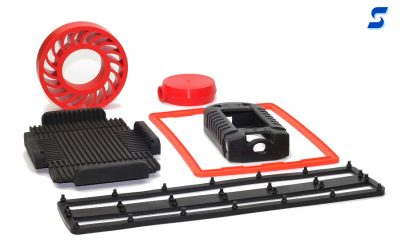Material
Silicone Rubber
The superior gasketing material formulated for extreme conditions, chemical resistance, and long-term functionality
The superior gasketing material formulated for extreme conditions, chemical resistance, and long-term functionality
The high performance properties of silicone elastomers are the reason it has become Stockwell Elastomerics’ core product family. Stockwell Elastomerics inventories silicone rubber sheets and silicone rolls that are readily converted into (custom gaskets and parts. Stockwell Elastomerics also (injection molds liquid silicone rubber (LSR) and compression molds specialty silicones such as electrically conductive silicones and (fluorinated silicone (fluorosilicone).
Common Silicone Rubber Applications
Silicone rubber (VMQ) is generally considered inorganic, meaning its backbone is not made up of carbon. The Si-O-Si backbone of silicones are stronger, longer and more flexible than C-O bonds found in organic rubber materials; this Si-O-Si backbone also accounts for silicone’s low glass transition temperature and stability in UV and ozone environments. Many commercially available carbon based elastomers, sometimes referred to as “black rubber”, degrade relatively quickly in outdoor environments as a function of the weaker carbon bonds breaking down.
Silicone polymers can be formulated in many ways to enhance key functional properties such as tear strength, elongation, compression set, and temperature range. Custom compounds are formulated to add or enhance silicone’s properties to meet finite functional requirements; these may include electrically conductive fillers for EMI applications or ceramic fillers for thermal management.
VMQ is the industry standard code for silicone rubber; the VM means vinyl methyl. VMQ silicone and VMQ rubber are other ways to refer to silicone rubber.
Properties – UV, ozone, long life, high energy return, and low compression set, wide temperature
Forms – solid liquid silicone rubber (LSR), solid gum, expanded foam, expand sponge, electrically conductive, thermally conductive
 Liquid silicone rubber (LSR) and high consistency rubber (HCR) are two families of silicone rubber. Liquid silicones are generally made from two part systems that are mixed and heat cured. LSRs can be cast into sheets or injection molded. HCRs are often mixed and supplied to manufacturers in gum form to be compression molded or roto-cured into sheets.
Liquid silicone rubber (LSR) and high consistency rubber (HCR) are two families of silicone rubber. Liquid silicones are generally made from two part systems that are mixed and heat cured. LSRs can be cast into sheets or injection molded. HCRs are often mixed and supplied to manufacturers in gum form to be compression molded or roto-cured into sheets.
There are two major cure systems used with processing silicone: addition cure and peroxide cure. Addition cured silicones, typically platinum catalyzed, are often formulated to make clean, low extractable rubber that is used in medical devices or food processing. Addition cure systems are commonly associated with LSRs but are readily available in HCRs as well.
Peroxide cure systems use free radicals to catalyze the curing process. Very often industrial grades of silicone rubber use peroxide curing system. Peroxide systems are most often associated with HCRs.
The above diagrams are courtesy of Wacker Silicones.
Stockwell Elastomerics manufactures custom silicone gaskets and silicone parts using a multitude of processes. Fast turn gaskets are manufactured by waterjet cutting or die cutting pre-formed sheets. Silicone rubber sheets are available in solids, foam or closed cell sponge. 3D parts can be liquid injection molded using liquid silicone rubber (LSR) or compression molded from gum based high consistency rubber (HCR). In addition to cutting and molding silicone, Stockwell Elastomerics laminates acrylic and silicone adhesives to pre-formed sheet before cutting. Other value added operations include application of conductive coating, custom assembly, and laminations of different materials for enhancing the physical properties of materials.
Contact Us for further assistance with silicone rubber (VMQ) materials used to manufacture gaskets and pads.